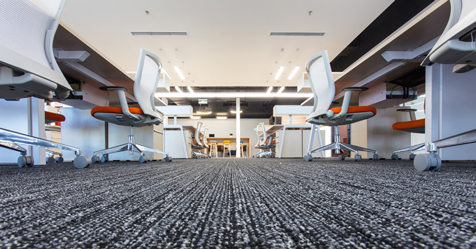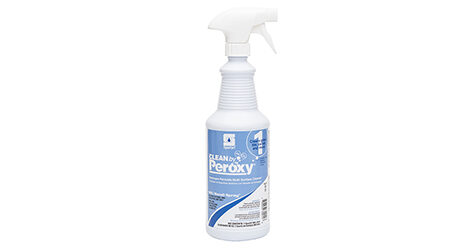In recent years, as the concept of sustainability has become more mainstream, carpeting made from natural resources, such as wool, plant fibers, and other ecologically focused materials, has become more popular in both residential and commercial spaces.
However, natural and plant-based fibers often react differently to water and chemicals, so it is crucial that cleaning and maintenance professionals know what treatments to use—and which ones to avoid.
If you’re trying to maintain a natural or plant fiber-based carpet, or are thinking of adding one to your building, the following tips can help to keep carpets made from environmentally-friendly materials in solid shape.
Natural Fiber Carpets
As a natural staple fiber, wool is durable and resilient, according to the Carpet and Rug Institute (CRI). It’s one of the most popular natural fiber carpet choices that Mike Woody, managing technician at ServiceMaster of Kalamazoo in Kalamazoo, MI, has seen, due in part to its durability. “Wool lasts longer than synthetic [fiber carpet],” Woody says. “When we talk to people, they say the carpet has been here longer than they have.”
Wool cleans well, ages gracefully, and helps trap allergens like dust, providing positive air quality—but it is also the most expensive carpet fiber, according to the World Floor Covering Association. Because of its expense, wall-to-wall wool carpeting is often used in commercial spaces designed with luxury in mind, such as hospitality suites and boardrooms, according to FloorDaily.net.
Wool can have some drawbacks; ripples, which present a potential tripping hazard, can occur if the primary and secondary backing separate, Woody says, and they require a professional to stretch the carpet out to correct the issue.
Hot-water extraction cleaning methods may also produce an odor. “Wool can have that wet dog smell,” Woody says. “Cooler temperatures help keep that to a minimum.”
Yet wool is far from fragile. In fact, wool’s structure actually helps it maintain its appearance.
“Wool is opaque; many other fibers are translucent,” says Institute of Inspection Cleaning and Restoration Certification (IICRC) instructor James “Jim” Smith, “so wool does a better job of hiding soil. Given its acidic nature and the acidic nature of soil, in general, wool repels soil because of the polarities.”
As a result, just vacuuming alone will often remove more soil from wool than from other fibers, requiring less periodic maintenance. “With synthetic fibers, they’re able to pick up soil fairly easily, and it’s more evident because soil can form a much higher bond with synthetic fibers than with wool,” Smith says.
When wool carpet does need a touch-up, wet cleaning methods can be particularly effective. “Wool responds extremely well to just agitation alone in terms of releasing soil,” Smith says.
Wool’s durability is a key reason building owners are often willing to pay more to install it wall-to-wall. “Wool, in general, tends to have about five times the life of a nylon carpet,” Smith says. “Most people feel like they got their money’s worth.”
Plant Fiber-Based Carpets
In addition to wool, some commercial spaces feature carpet made from plant-based fibers, such as jute, a strong vegetable fiber; sea grass; and sisal, a plant that’s cultivated for its fibers in a number of countries, according to the International Natural Fiber Organization.
Sisal can survive in areas with little rainfall—and fittingly, the material doesn’t require much water during the cleaning process. Some manufacturers and cleaning service providers recommend only using water sparingly, if at all.
“[When cleaning] sisal and sea grass and other [like materials], the issue is absorption—it increases the volume size of the fiber,” Smith says. “Especially in the case of a flat weed, filaments swell due to absorption and can cause the fabric to shrink.”
In addition to water, oxidizing agents may also not mix well with cellulosic fibers, according to Smith, and should generally be avoided. “Repeated use of a strong oxidizer could make [a cellulosic fiber carpet] hard and brittle,” he says.
As with many flooring types, periodic maintenance of plant fiber-based and natural fiber carpet can only do so much if the daily maintenance provider isn’t properly caring for the material. To prevent permanent damage from occurring in between professional treatments, consider proactively advising any individuals who will handle the carpet’s daily care—ranging from building managers to store clerks—about how to treat stains.
Water-soluble spots, such as coffee and soda spills, make up approximately 10 percent of the overall soiling in a facility, according to Tom Enright, senior vice president at commercial flooring, carpeting, and hard surface product producer Mohawk Group. “All that is needed, in the vast majority of cases, to effectively address waterborne spots and spills is a mild (close to neutral pH) cleaning agent—and to make sure that you don’t exacerbate the issue by introducing a large volume of additional liquid that just serves to push the spot/spill down and out,” Enright says.
Some products can cause more problems than they may solve. For example, sunlight can cause over-the-counter alkaline spot treatments to continue working if they aren’t fully rinsed out, which can start to bleach out portions of a carpet, according to Woody.
Woody suggests telling customers to blot and try to remove any spills with club soda, and, if they insist on using a spot treatment, to use a half-and-half white vinegar and water solution afterwards. “White vinegar and water won’t do any damage to the fibers or colors,” he says. “It’ll just neutralize the product so it stops working.”
If customers have ground stains into an area rug with aggressive blotting or other removal methods, he recommends taking the rug off-site for repair. “If it’s permeated the fibers, I may have to take multiple steps to restore the rug to its previous condition,” he says. “Urine or vomit can be a multiple-day process.”
Other Eco Options
In addition to plant and natural fiber carpet, some commercial spaces have begun installing sustainable carpet made from recycled materials.
Carpet tiles—such as squares from modular floor covering provider FLOR, which are made with recycled nylon, bottles, and other items—are popular because they can be individually installed and removed, reducing replacement costs.
If one area of the carpet is damaged, facilities simply need to replace a tile, instead of ripping the carpet out and installing a new one, reducing expense and material waste, according to the U.S. Environmental Protection Agency (EPA). Even large, high-traffic tile areas can be replaced fairly easily because suppliers offer dye lots that can be merged with one another, minimizing the need for replacement stock, according to Floor Covering Weekly.
Some manufacturers are also producing fiber blends that are partially created with recycled content. Mohawk, for example, produces Duracolor fiber, made with 30 percent recycled content. Similarly, product and service provider DuPont produces Sorona, a polymer that contains 37 percent renewably sourced, plant-based content, which, in commercial spaces, can be cleaned using a hot-water extraction method.
Green Carpet Considerations
Thinking of installing new carpet in a commercial space? Keep the following environmental ideas in mind.
- Buy carpet with better backing: More than 90 percent of commercial carpet is tufted and consists of a primary backing fabric, applied bonding adhesive, and a secondary backing, cushion, or hard back, according to the EPA.
Not-for-profit organization Green America recommends purchasing carpets with natural fiber backings that have been attached using adhesives with a low toxicity. The Carpet and Rug Institute’s Green Label Plus adhesives list can provide some options with low-VOC emissions that the organization has certified.
- Consider alternative padding: The EPA recommends looking for an alternative to polybrominated diphenyl ethers (PBDEs), which have been used in the past as flame retardants in carpet cushion. Their use has generally been discontinued due to the Significant New Use Rule (SNUR) under the Toxic Substances Control Act, in which the EPA said it believed the substances “may be hazardous to human health and the environment.”
Sustainable Fiber Maintenance
Whether you’re dealing with wool, a plant fiber-based carpet, or carpet made from recycled materials, cleaning service providers should know the material treatment basics to ensure they aren’t oversaturating or otherwise damaging its fibers.
They may, however, not need to schedule exceptionally frequent maintenance visits. Woody recommends treating low- to medium-traffic areas once per year to once every other year, and medium- to high-traffic areas approximately every six months to a year.
When properly maintained, natural and plant fiber-based carpeting can hold up amazingly well—even in high-traffic areas, like the auditorium Woody cleans annually that installed expensive wool carpet about three years ago. “They put highly detailed, decorative flooring down, wanting it to last a really long time,” he says. “They do all the preventative maintenance and follow all the steps to make sure the colors and fibers hold up—and the carpet still looks great.”



